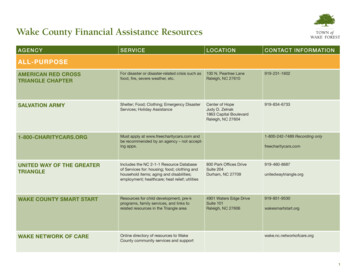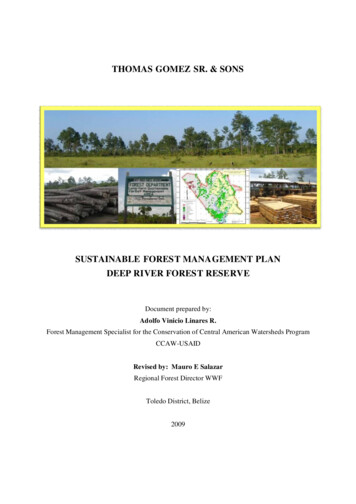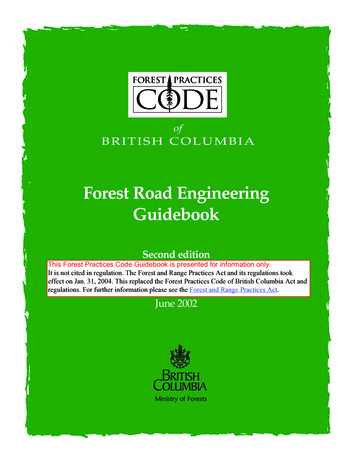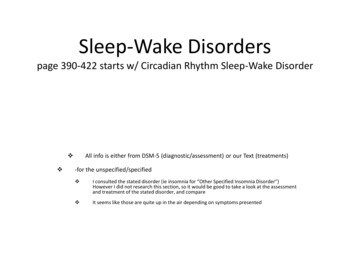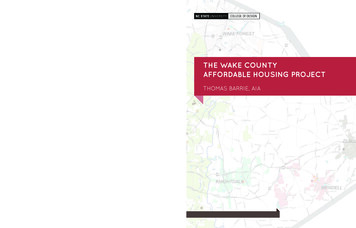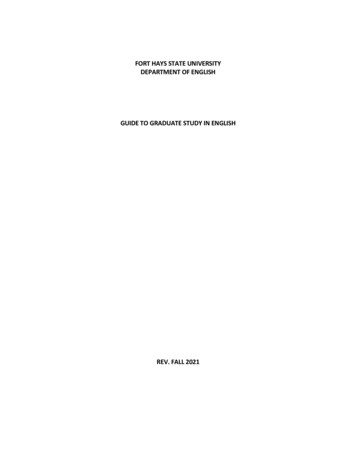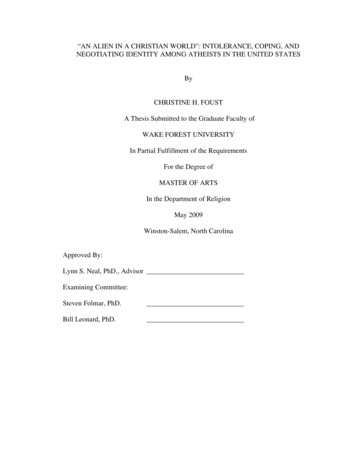
Transcription
“AN ALIEN IN A CHRISTIAN WORLD”: INTOLERANCE, COPING, ANDNEGOTIATING IDENTITY AMONG ATHEISTS IN THE UNITED STATESByCHRISTINE H. FOUSTA Thesis Submitted to the Graduate Faculty ofWAKE FOREST UNIVERSITYIn Partial Fulfillment of the RequirementsFor the Degree ofMASTER OF ARTSIn the Department of ReligionMay 2009Winston-Salem, North CarolinaApproved By:Lynn S. Neal, PhD., AdvisorExamining Committee:Steven Folmar, PhD.Bill Leonard, PhD.
TABLE OF CONTENTSINTRODUCTION .1Religious Intolerance in AmericaAbout This ProjectMethodsEthical ConsiderationsCHAPTER I .16“BEING AN ATHEIST IN AMERICA ISN’T EASY”:INTOLERANCE TOWARD ATHEISTS IN THE UNITED STATESIntroductionImpressions of ExclusionAccounts of IntoleranceLocation and DiscriminationAccepting and Unaccepting GroupsConclusionsCHAPTER II .36“PEOPLE YOU CAN TALK TO WITHOUT GETTING THAT WEIRDLOOK”:COMING OUT, COMMUNITY, AND NARRATING IDENTITYIntroductionComing OutAtheist GroupsNarrating IdentityConclusionsCHAPTER III 61“WE WANT TO SHOW AMERICA THAT WE ARE GOOD CITIZENS”:PRESENTING ATHEISM TO AMERICAN SOCIETYIntroductionAtheism on the Public StageActivismNon-Theist TermsConclusionsCONCLUDING THOUGHTS .80BIBLIOGRAPHY .82ii
ACKNOWELDGEMENTSMy respondents provided me with a wealth of information and an intimate lookinto their lives. They made me laugh and made me cry. I am very grateful to have metmany people who so readily invited me into their lives and shared their stories, their fears,their hopes, their jokes, and their pain with me. I am indebted first and foremost to them.I am also grateful for the excellent instruction I have received from theDepartment of Religion over the past two years. I have learned a few facts along the way,but more importantly the faculty has taught me how to think, how to write, and how toask the right questions.I would like to thank Professors Lynn Neal, Steven Folmar, and Bill Leonard forserving on my defense committee and for their valuable comments. Dr. Folmar’s adviceduring the beginning stages of this project have proved to be invaluable. Hisencouragement, honesty, and humor have been extremely helpful. Dr. Neal has had acritical role in this project as my advisor. She has always made herself available to helpme, and her intelligence and kind support have encouraged and motivated me. I am luckyto have had such a wonderful advisor.A special thanks also goes to my family and friends who graciously listened to meramble about this project for the past year and continued to love me anyway.iii
INTRODUCTIONWhat does it mean to be an atheist? Most scholarly works that focus on atheism inthe contemporary United States answer this question by studying how people come to notbelieve in a god. This study however is not concerned with that type of question, butrather examines atheism in a different sense by asking other questions. How doessomeone make the decision to claim this identity? How does that identity influencesomeone’s life? How do atheists negotiate their minority status? While the label “atheist”can be imposed from the outside on anyone who does not profess belief in a god, andphilosophically speaking this would be correct, not everyone who lacks belief in a godchooses to claim and construct an atheist identity for themselves. Choosing to labeloneself as an atheist in interaction with others entails more than a simple description ofbeliefs. Choosing to self-describe as an atheist in the contemporary United States meansnot believing in a god and actively creating an identity which entails labeling oneself as aminority, negotiating minority status, dealing with discrimination and intolerance, andsituating yourself in the American religious landscape that stereotypes atheists sonegatively that you are aligned with the “most hated minority in America.”1Religious Intolerance in AmericaTo begin to understand intolerance toward atheists, we must first examine theAmerican religious context. Beyond the glorified image of the American “melting pot”lies the grim reality of intolerance. Religious intolerance in particular has plagued thehistory of the United States. While Americans technically have freedom of religion, this1News coverage and various other responses to “Atheists as ‘Other’: Moral Boundaries and CulturalMembership in American Society” (Egdell, Penny, Douglass Hartman, and Joseph Gerteis, AmericanSociological Review 71 (April 2006)) used variations on the label “most hated minority in America.”1
does not obligate people to accept others’ religious choices. Religious intolerance isprejudice against individuals or groups based on religious affiliation, and manifests inovert and covert hostility as well as in the many disadvantages minority members face onthe societal and institutional levels and in one-on-one encounters.2 Examples of religiousintolerance in American history abound, from exclusion and isolation to stereotyping andscapegoating to violence and murder, and everything in between. This study of atheists inAmerica provides one more example of religious intolerance in the United States.However, the major difference is that this group experiences persecution not for aligningwith a particular set of religious creeds and practices but because they construct theiridentity in opposition to those who do align with religious creeds and practices.America has often been described as particularly religious. The fact that the vastmajority of people in the United States (approximately 83 percent)3 claim a religiousaffiliation definitely contributes to the feeling of exclusion atheists report. America hasalso been described not simply as quantitatively more religious but also qualitativelymore religious. Some have attempted to describe the American religious climate throughnegotiating the term “civil religion,” which is hard to define and even harder to assess.The term originally belongs to Jean-Jacques Rousseau but was first popularized in theAmerican religious context in Robert Bellah’s 1967 essay “Civil Religion in America.”He writes, “Civil religion is at its best a genuine apprehension of universal andtranscendent religious reality as seen in the experiences of the American people.” Hegoes on to declare that God has been the clear central symbol, but myriad other symbols,2“What is Intolerance?” Portraits of Hate, Lessons of Hope g/user-guide/what-is-intolerance.3The Pew Forum on Religion and Public Life, “U. S. Religious Landscape Survey,” 2007,http://religions.pewforum.org/affiliations.2
rituals, and biblical archetypes also play a role.4 Bellah demonstrates that most people inthe United States share common religious characteristics, which are not exclusivelyChristian but emerge mainly from that tradition. Since Bellah, “civil religion” has beenvariously defined to include many thoughts about America’s special relationship withGod from the founding of the country to present day, including ideas such as divineprovidence, a “city on a hill,” a new Israel, “a righteous empire,” a moral leader in theworld, and God’s chosen people.5 “Civil religion,” it seems, is made up of biblical themes,narratives, and symbols blended with American nationalist themes, narratives, andsymbols, and the resulting amalgamation is interpreted through mainstream Christianvalues.6 These values have been institutionalized since they are expressed in America’sfounding documents, in the religious rhetoric of American political figures, and in whatmany people believe it means to be an American.Because of these trends, belief in God has become a social norm.7 The symbol ofGod exerts such power because it can be interpreted in so many ways. There is only tacitagreement on an approximate meaning, so the task of specific interpretation falls on theindividual who can hear “God” as something meaningful and positive to them. Sincepeople can interpret this sign in any way they want, it is easy for most Americans to feelcomfortable with its use in public discourse. This makes God a potent and effective4Robert N. Bellah, “Civil Religion in America,” Daedalus 96, no. 1 (Winter 1967): 12, 15.5Bryan F. LeBeau, The Atheist: Madalyn Murray O’Hair (New York: New York University Press, 2003),10-11.6John F. Wilson, Public Religion in American Culture (Philadelphia: Temple University Press, 1979), 19,28.7Kevin J. Christiano, William H. Swatos, Jr., and Peter Kivisto, Sociology of Religion: ContemporaryDevelopments (Walnut Creek, CA: AltaMira Press, 2002), 69-70.3
symbol. 8 For example, references to God in political rhetoric often serve a unifyingfunction, because they perpetuate a vague Judeo-Christian religiosity and help politicalleaders convey their esteem for religious belief, just like the “average American.”9 Thus,we can see how Americans who believe in God resonate with such social and politicaldiscourse. However, references to God exclude atheists since they do not relate to thissymbol that connects most Americans, and they are left out of this ideologicalcamaraderie.Another way to see how minority religions in America are excluded is to considerthe narratives of freedom many of us are taught as children. Textbook narratives ofAmerican history construct a powerful American identity. Because Protestants have beenthe numerical majority and because they have exerted the most power throughout thehistory of the United States, their story is often presented as the American story. Therepetition of histories in which Protestants are the central and righteous figures is apowerful way of asserting cultural dominance.10 This Protestant bias means that manypeople who belong to minority religions are left out of histories or relegated to playing asupporting role, which only emphasizes Protestant glory and dominance. Exclusion fromthe narrative of American religious history means being left out in more immediate andconcrete ways as well.11 By excluding minority groups from historical narratives, their8Catherine Bell, Ritual Theory, Ritual Practice (New York: Oxford University Press),183-184.9Robert Wuthnow, The Restructuring of American Religion: Society and Faith since World War II(Princeton: Princeton University Press, 1988), 244.10J. Hillis Miller, “Narrative,” in Critical Terms for Literary Study, ed. Frank Lentricchia and ThomasMcLaughlin (Chicago: University of Chicago Press, 1990), 72.11Thomas A. Tweed, “Introduction: Narrating U.S. Religious History,” in Retelling U.S. Religious History,ed. Thomas A. Tweed (Berkeley, California: University of California Press, 1997), 2, 13.4
existence and their struggles are not recognized. Minority groups and the intolerance theyface do not fit into the grand celebrations of religious liberty that many Americannarratives present. This can give the misleading impression that instances of religiousintolerance in the United States are aberrant phenomena. When problems are obscuredand people do not comprehend the pervasive reality of religious intolerance in the UnitedStates, people are more likely to show apathy toward protecting religious freedom.12Religious intolerance is and has been a major problem in American history.Majority groups, particularly Protestants throughout the history of religion in the UnitedStates, have often acted intolerantly to protect their dominant position and to reinforce theboundary between “us” and “them,” between insider and outsider. This helps the majorityconstruct their identity as well as keeping the minority in a disadvantaged position. Thiskind of boundary construction is a crucial part of the process of defining individual andgroup identities. Dominant religious groups understandably fear losing their power andprivilege in society.13 By defining who fits in the dominant group and who does not,members of the majority construct their identity and seek to control those around them.One of the most common ways in which this “dialectic of inclusion and exclusion”14 hasbeen employed in the United States is by defining who is and who is not an American – afrequent component of religious intolerance.12John Corrigan and Lynn S. Neal. Introduction to Religious Intolerance in the United States: ADocumentary History. (Unpublished Manuscript).13John Corrigan and Lynn S. Neal. Conclusion to Religious Intolerance in the United States: ADocumentary History. (Unpublished Manuscript).14Robert. N. Bellah, “Conclusion: Competing Visions of the Role of Religion in American Society” inUncivil Religion: Interreligious Hostility in America, ed. Robert N. Bellah and Frederick E. Greenspahn(New York: Crossroad, 1987), 219.5
“Un-American-ness” has been a device used against almost every religiousminority in United States history to create an “us” versus “them” mentality, evenpertaining to religions that started in America, such as Mormonism. Anti-Semites claimthat Jews are foreigners who are plotting to take over the United States. People fear thatCatholics are not truly American because they answer to a foreign Pope. In addition,Catholicism’s celibate priesthood is perceived as sexually deviant and challenges the ideaof the traditional American family. Asian religions are considered too strange and exoticto ever fit into mainstream American society, and they are often criticized for idolatry.Most recently, Islam has faced persecution because of some foreign Islamic groups’violent actions and rhetoric against America. All of these groups claim a god or gods, butit has certainly not freed them from persecution in the United States, demonstrating that“One Nation Under God” often refers to a Protestant conception of God, religion, andAmerica. Minority religious groups are persecuted for their deviant beliefs and theirrejection of mainstream mores.15 Mainline Protestantism has come to connote “normal”while other religious alternatives are deemed strange and tatheistsmanifestedparticularlyvehemently during the Cold War. The rhetoric of public figures presented the war as notonly a battle between two nations, but a battle between atheism and Christianity.17 AsPresident for most of the 1950s, Dwight D. Eisenhower both reflected and perpetuated15Khyati Y. Joshi, New Roots in America’s Sacred Ground (New Brunswick, New Jersey: RutgersUniversity Press, 2006), 121.16R. Lawrence Moore, Religious Outsiders and the Making of Americans (New York: Oxford UniversityPress, 1986).17Stephen Bates, “‘Godless Communism’ and Its Legacies,” Society 41, no. 3 (March-April 2004): 30.6
the climate of heightened religiosity during the beginning of the Cold War.18 PresidentEisenhower’s views of the Christian faith supported his ideas about America’s role in theworld. He declared that God was on America’s side in the fight against the USSR, and heproclaimed that democracy is “a political expression of deep and abiding religion.” Hemade frequent statements about the link between America and Christianity in the fightagainst “godless Communism.”19 Americans were labeled “humble servants of a proudideal” in the midst of a “crusade.”20 He echoed similar sentiments in a 1955 address tothe American Legion:Without God, there could be no American form of government, nor anAmerican way of life. Recognition of the Supreme Being is the first –the most basic – expression of Americanism.21While Eisenhower spoke the most of any president about the dangers of atheisticCommunism, President Ronald Reagan brought back some of the same rhetoric when hewas in office. In March of 1981, President Reagan addressed the Conservative PoliticalAction Conference with the following words:The Marxist vision of man without God must eventually be seen as anempty and a false faith – the second oldest in the world – first proclaimedin the Garden of Eden with whispered words of temptation: “Ye shall beas gods.”2218Robert S. Ellwood, The Fifties Spiritual Marketplace: American Religion in a Decade of Conflict (NewBrunswick: Rutgers University Press, 1997), 70.19J. Ronald Oakley, God’s Country: America in the Fifties (New York: Dembner Books, 1986), 153, 320.20LeBeau, The Atheist: Madalyn Murray O’Hair, 236-237.21Dwight D. Eisenhower, Remarks Recorded for the “Back-to-God Program” of the American Legion –February 20, 1955. Dwight D. Eisenhower Memorial Commission ns/quotesbydate.htm.22Betty Jean Craige, American Patriotism in a Global Society (New York: State University of New YorkPress, 1996), 101.7
The biblical reference directly depicts Communism as not just godless, but satanic. Byequating Communism with Satan and equating America with God, it is no surprise thatmany Americans hold extremely negative opinions of atheism and that atheists arediscriminated against in the United States today. This Cold War legacy of distrustingatheists lingers still.Current websites show this intolerant legacy. For example, one website titled“Atheist Communism is Evil” reports statistics on all the deaths for which Communistcountries have been responsible. The site concludes that genocide comes naturally toatheists, because “atheists are evil.” 23 Another website also reports instances of massmurder under atheistic Communism to counter atheists who point out that Christianityhas been responsible for many deaths throughout history, such as those caused byinquisitions and crusades. The “Militant Atheism Exposed” website claims that atheists“conveniently fail to mention the tens of millions killed by atheist-communiststhroughout the past century.”24 While rhetoric associating Communism with atheism isstill present, most anti-atheism intolerance on the internet today focuses on condemningatheists to hell and showing Christians that atheists are dangerous because of their lack ofmorality. One such website claims that Satan was the first atheist, and that atheists todayare the “closed-minded subjects of Satan.” 25 Other sections of the “Militant AtheismExposed” website claim that atheists have “flexible sexual morals,” “that relationshipsbetween atheists are a vortex of instability with much accompanying turmoil and mental23Atheist Communism is Evil website. istkillers.html.24“Militant Atheism’s Mistakes,” Militant Atheism Exposed website,http://atheismexposed.tripod.com/atheism mistakes.htm.25“Exposing the Atheist,” Society for the Practical Establishment and Perpetuation of the TenCommandments website, http://www.tencommandments.org/heathens5.shtml.8
anguish,” “they are driven by a hatred for the unborn,” and that “higher-level morality isnot achievable by atheists.”26 Based on this kind of incendiary writing, we see how manyAmericans get their negative impressions of atheists. Hit counters on some of thesewebsites number in the millions.About This ProjectThere are not many studies focused on atheists in the contemporary United States.The few that exist usually focus more on what makes someone become an atheist or whatatheism means philosophically. This study attempts to add to these previous works in adifferent way – by studying atheists, not atheism. Because of this, my study resemblesthe study of minority religions in America more than it resembles some of the currentwork on atheism. Atheists in the United States face discrimination based on their beliefsmuch like Hindus, Muslims, or Mormons might. Like minority religions, atheism poses aperceived threat to the dominant Christian culture. Also like minority religions, atheism isoften accused of promoting immoral behavior because their ideas do not match up withdominant Christian values. Atheists, like other minorities, take refuge in theircommunities because they are a safe place away from the dominant culture thatpersecutes them. For most religious minorities, boundaries of inclusion and exclusion aredrawn by the religious majority as well as by the minority group, and this emphasis ondifference serves the important function of identification, showing people who they areby showing them who they are not.Perhaps the biggest difference between atheist communities and minorityreligious groups is that atheists often receive harsher treatment in today’s society, and thisdiscrimination often goes unnoticed. It seems that tolerance toward different religions has26Militant Atheism Exposed website, http://atheismexposed.tripod.com/.9
gradually become more expected, and as a result has brought more religious “outsiders”into the fold of acceptability and American-ness. A general movement from Protestant, toChristian, to Judeo-Christian, to Abrahamic faiths, to all people of faith as “One NationUnder God,” has let everyone else in, at least ideologically. However, the increasedacceptance of religious diversity does not extend to the non-religious.27 As we will see,atheists face shocking levels of intolerance despite the supposed acceptance of pluralismin America.Literature to date that does discuss atheists in the contemporary United Statesusually gives a one-sided look at these individuals and groups. Richard Cimino andChristopher Smith’s article “Secular Humanism and Atheism beyond ProgressiveSecularism,” for example, concludes that people join non-theist groups because they needto unite in activism.28 As we will see in this project, however, there are many reasonspeople join atheist groups, and the majority join for social and personal reasons that havelittle to do with activism. Bridget Fitzgerald’s “Atheists in the United States: TheConstruction and Negotiation of a Nonnormative Identity” is on the other side of thespectrum and deals with atheists only as individuals, not in groups.29 My motivation forthis project was to synthesize these approaches, since group activity and personalnegotiation of identity are both crucial for getting an in-depth look at what it means to bean atheist in the United States. Both of these works are valuable resources, but in myproject I wish to take both of their viewpoints together to consider how atheists deal with27Penny Egdell, Douglass Hartman, and Joseph Gerteis, “Atheists as ‘Other’: Moral Boundaries andCultural Membership in American Society,” American Sociological Review 71 (April 2006): 211, 214.28Richard Cimino and Christopher Smith, “Secular Humanism and Atheism beyond ProgressiveSecularism,” Sociology of Religion 68, vol. 4 (2007).29Bridget Fitzgerald, “Atheists in the United States: The Construction and Negotiation of a NonnormativeIdentity” (Ph.D. diss., State University of New York, 2003).10
their minority identities as individuals and how atheist groups try to engage with societyat large.By taking this two-sided approach, we see how atheist communities serve crucialfunctions for their members. By aligning with a group, atheists create a social space inwhich to narrate their identities as atheists by drawing boundaries of inclusion andexclusion. Atheists, cognizant of these symbolic boundaries, then choose where and whento avoid emphasizing these demarcations in their personal lives. Since this minority statusis not visible, like it would be for an ethnic minority, atheists have the power asindividuals to choose when to disclose this stigmatized minority status. Negotiation oftheir identities in this way influences micro-level concerns, such as whether or not todisclose their atheism in a one-on-one situation, and macro-level concerns, such aswhether or not to present oneself as an atheist to society by engaging in activities as amember of the atheist community.The goal of this project is to situate atheists in the context of religious intolerancein America through their own voices, and to provide a rich picture of what if means to bepart of this minority. We will examine how they see their place in American society, howthey negotiate their identities and seek refuge in atheist communities to deal with theirminority status, and how they address macro-level concerns about intolerance bychoosing how they want to portray atheism to society at large. While this study started bylooking for people who claimed any type of non-theist identifier, all of my respondentsclaimed the term atheist and/or were part of a group that used the term atheist, so“atheist” serves as the general term I use to refer to them and their communities.11
MethodsThe data for this project was collected through twenty-six interviews and sixparticipant observation experiences. Three different data collection methods were usedfor redundancy, or “triangulation,” meaning that multiple sources confirm or dispute eachother giving a more complete picture of the group studied.30 This project uses participantobservation, informal interviewing, and formal interviewing. By asking my respondentsin one-on-one interviews about their group and what they get out of it, I checked thatinformation by actually observing the group, and by asking the members about what thetypical meet-up looks like, I checked whether or not what I attended was ordinary.Following the advice that ethnographers “gather most of their data throughparticipant observation and many casual, friendly conversations,” I interacted withmembers at group meet-ups to get most of my information.31 While trying to keep theseconversations informal, I also tried to balance ethical concerns like explaining my projectgoals to my respondents.32 Most of my data has come from participant observation, and Ihave found that interviews back up that data.The participant observation approach allowed me to witness atheist meet-ups.Most group gatherings I attended were referred to as “meet-ups,” not meetings. Onerespondent speculated that the name “meet-up” conveyed the informal environment, andusing the term “meeting” would have made their gathering sound too planned and formal.Also, many of these groups are organized through meetup.com, so the term is probably30Margaret D. LeCompte and Jean J. Schensul, Designing and Conducting Ethnographic Research(Lanham, Maryland: AltaMira Press, 1999), 131.31James P. Spradley, The Ethnographic Interview (New York: Holt, Rinehart, and Winston, Inc., 1979), 58.32Ibid., 59.12
borrowed from this website. Having no prior experience with these groups, I found outhow a meet-up is organized, what is discussed, how members participate, and what kindsof emotional reactions meet-ups can evoke. This approach allowed me to view groupmembers interacting normally. Since one of my main goals was to find out what peopleget out of being in these groups, observing community behavior showed me what suchinteraction is like. Interviewing about this topic then allowed my respondents to elaborateon what these interactions mean to them, and it helped to know what they were talkingabout having seen it first hand. I was also able to observe speech in which the membersdefined themselves. I collected data about what terms are most used among a set of termsthat can all be used to describe non-theists (atheist, agnostic, freethinker, bright, secularhumanist). Since some of these terms are used negatively by outsiders, I was able toobserve the active reappropriation and reinterpretation of these terms. I also observedhow speech defined their group in opposition to society as a whole or to a specific outsidegroup. The limitations to this method were mostly logistical: by not having the time toundertake a longer study and attend several meet-ups, I may have missed out on noticingsome recurring themes.The informal interview approach allowed me to interact with group memberscasually to get their reactions to the meet-ups. The informal approach also allowed peopleto tell me what they think without being prompted. This way I saw how they reacted tomeet-ups, what they thought was important about the meet-up to discuss, and howmembers felt about the meet-up as a whole or about particular parts. Though thisapproach seeks a more natural conversation with members, the biggest limitation to this13
method is that a truly natural conversation was impossible given my status as a researcher,and thus an outsider.The formal interview approach allowed me to obtain data on specific topics. Iinquired about more personal feelings and stories without worrying about the influence ofa respondent’s peers. By asking specific questions, I was able to compare differentmembers’ responses and notice patterns in the data. This also provided in-depth,qualitative information. By asking the subjects to respond to open-ended questions aboutthemselves, they told me about what they find relevant. This is the only method where Icould collect personal stories verbatim. It is also the only method where I could inquirecomprehensively about feelings and beliefs in relation to the meet-ups and thecommunity, their status as atheists, reasons they use different terms for self-identification,and whether or not they agree with group identifiers. I used this information incomparison with data from meet-ups to find out how they speak similarly and differentlyin these two contexts. While there were topics and questions I knew I wanted to cover, Ialso wanted to find out what was important to members, so I asked my respondents at theend of formal interviews what parts of their lives as atheists they thought were importantto discuss that we did not already cover and what facts or topics they thought wereimportant for understanding them. 33 Since I also collected a lot of my data throughparticipant observation at meet-ups, I listened to the topics they brought up for discussionand then asked follow-up questions to the individuals based on these topics. Thelimitations of this method were primarily that subjects could present me with whateverthey wanted. Luckily, I had good respondents who, for the most part, did answer the33Ibid., 136.14
questions I presented wh
NEGOTIATING IDENTITY AMONG ATHEISTS IN THE UNITED STATES By CHRISTINE H. FOUST A Thesis Submitted to the Graduate Faculty of WAKE FOREST UNIVERSITY In Partial Fulfillment of the Requirements For the Degree of MASTER OF ARTS In the Department of Religion May 2009 Winston-Salem, North Carolina Approved By:
